|
| |
For Immediate Release
Press Contact: Leena Sukumar leena.sukumar@gmail.com or admin@iaac.us
Indo-American Arts Council Inc.
212 594 3685 |
| |
| INDO-AMERICAN ARTS COUNCIL PRESENTS IT'S SIXTH ANNUAL
ERASING BORDERS FESTIVAL OF INDIAN DANCE |
| |
| Performances in Bharatanatyam, Mohiniyattam, Odissi, Kathak, Kalbeliya, Kuchipudi |
| |
Erasing Borders: Festival of Indian Dance was launched by the Indo-American Arts Council in 2008 to promote Indian dance in New York City, the global capital for dance. This premier event brings to New York Indian and India-inspired dance in an array of forms, old and new: concerts, feature performances traditional and experimental, classical and post-modern, folk and popular.
The festival has been known to bring to the New York City audience a range of Indian dance performances from traditional and classical to modern and Indian dance. We present exciting new works produced in India and in the Diaspora.
The 6th edition of Erasing Borders Festival of Indian Dance has been curated by the Indo-American Arts Council (IAAC) and will be presented at Battery Park on August 15th, at La Mama's Ellen Stewart Theatre on August 16th and at La Mama's Rehearsal Studio on August 17th.
On Thursday, August 15th, India’s Independence Day, the IAAC, in collaboration with the Downtown Dance Festival, will present Free Lunch-time Performances at Battery Park. The program will include performances by Vijayalakshmi, exponent of the Mohiniyattam South Indian style; Rani Khanam, exponent of North Indian Kathak; Rahul Acharya representing the Odissi style from Eastern India; and Rama Vaidyanathan, one of India's top young exponents of Bharatanatyam. The Battery Dance Company’s Annual Downtown Dance Festival was initiated in 1982 to introduce a wide variety of worthy dance companies of all genres to the large and diverse audiences that gather in lower Manhattan’s public spaces.
The festival is supported, in part, by public funds from the New York City Department of Cultural Affairs (DCA) and New York State Council for the Arts(NYSCA). More information can be found at www.iaac.us. Twitter users can keep track of festival updates by using the @IAACus hashtag. |
| |
| |
Celebrating the Indian Independence Day on August 15, 2013 at Battery Park, NYC
Erasing Borders: Festival of Indian Indian Dance |
| |
| |
| Introduction by Aroon Shivdasani, IAAC Executive & Artistic Director, & Jonathan Hollander, Artistic Director Battery Dance Company |
| |
| Rajika Puri: Narrator ('carrier of the thread' or Sutradhar) |
| |
| Balagopala Tharangam |
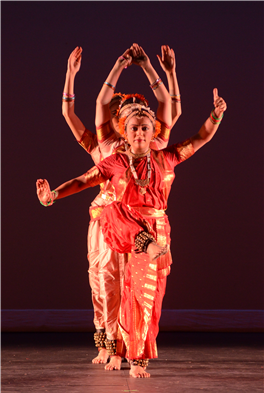 Dancers: Samarpita Bajpai, Kirstie McDermott and Krystal Bryan of Gurukul Dance Academy Dancers: Samarpita Bajpai, Kirstie McDermott and Krystal Bryan of Gurukul Dance Academy
Music: C.R. Acharya
Choreography: Guru C.R. Acharya (of Darpana Dance Academy, Ahmedabad)
This dance is an offering to the dark and handsome cowherd Krishna, beloved son of chieftain Nanda and his wife Yashodha. Within the scope of the narrative, dancers execute complicated rhythmic sequences balanced on brass plates with pots of water on their heads and lamps in both hands. A distinctive and popular dance of traditional Kuchipudi from south India, Gurukul's Tharangam is in a style not commonly seen outside Gujarat.
|
| |
| Mayil Kuthu (Mohiniyattam) |
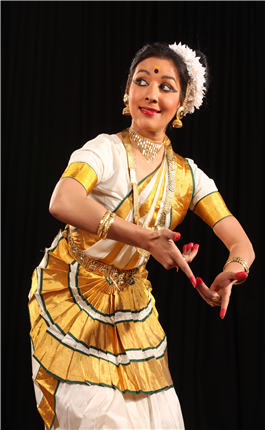 Dancer: Vijayalakshmi Dancer: Vijayalakshmi
Choreography and lyrics: Kavalam Narayana Panicker
Music: Sadanam Radhakrishnan in Raga Begada followed by Poraneer set to Talamalika.
This item describes a peacock’s grief in not finding any sign of rain - a metaphor of the soul's yearning for liberation. The peacock prayers are soon answered when dark clouds gather. And when it rains, it seems like a marriage between heaven and earth. Nature rejoices, the young shoots sprout, while the cool breeze caresses. The peacock dances in ecstasy. |
| |
| Chakravaha Pallavi |
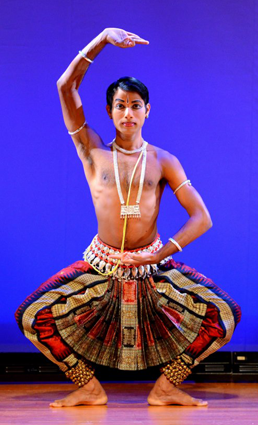 Dancer: Rahul Acharya Dancer: Rahul Acharya
Raga: Chakravaka Tala: Ektali
Choreography: Guru Durga Charan Ranbir
This dance forms the third chapter of the Odissi repertoire. Pallavi comes from the Sanskrit word Pallava, meaning a tender leaf. The dance begins with slow pulsating and accelerates as it goes on, taking the time to mature into a fully grown, adult tree swaying in the breeze
|
| |
| Kalbeliya |
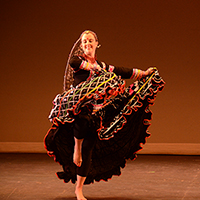 Dancers: Samarpita Bajpai, Kirstie McDermott and Krystal Bryan of Gurukul Dance Academy Dancers: Samarpita Bajpai, Kirstie McDermott and Krystal Bryan of Gurukul Dance Academy
Staging: Samarpita Bajpai, in collaboration with Jaisalmer Kalbeliya dancers.
Costumes, music developed in consultation with the Kalbeliyas from Jaisalmer.
This dance of the Kalbeliyas, a clan of snake charmers from the state of Rajasthan, is characterized by dizzying spins and serpentine movements.
|
| |
| Mayur Allaripu |
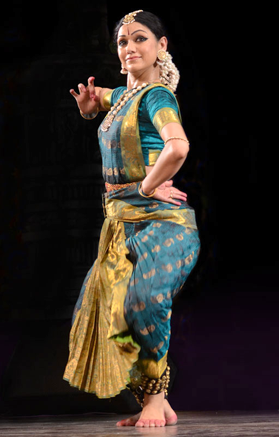 Dancer: Rama Vaidyanathan Dancer: Rama Vaidyanathan
Choreography: Rama Vaidyanathan
Music: Rhythmic syllables composed by K Sivakumar
This is an unusual Alarippu, in that the choreography combines the Alarippu structure of the traditional Bharatanatyam repertory with the motif of a peacock. Instead of the usual flat palm hand position (Pataka Hasta) this bird with a colorful tail is shown using the peacock hand position (Mayura Hasta).
|
| |
| Raas Lila (Bharatanatyam) |
Dancer: Rama Vaidyanathan
Choreography: Rama Vaidyanathan
Music: G. S. Rajan
Lyrics: medieval poet Soordas
When Krishna played his melodious flute, the young women of his village abandoned everything to join in this Dance of Love. The whole world was attracted to him. Animals and birds, including the peacock, swayed to his music. The Raas Leela gradually builds to a crescendo when the women surrender themselves completely to Krishna. Each one feels that Krishna is dancing only with her. The Leela symbolizes the play of Oneness with the many, that the Ultimate Being is everywhere. The dancer embodies the deep wish of human devotees to be united with that cosmic consciousness |
| |
| Nritta & Abhinaya |
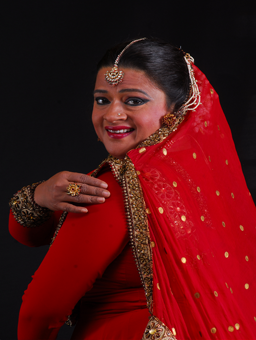 Dancer: Rani Khanam Dancer: Rani Khanam
Following the court traditions of Kathak, where there was an interactive relationship between dancer and sponsor/audience, Rani will share some techniques specific to the Lucknow style in a format that is different from that of concert dance. First she will show us different kinds of abstract, rhythmic dance patterns (Tukra, Paran, Parmelu, Ladi ...), then show us the same repertory performed with dramatic expression (Abhinaya). Through footwork and facial expression she might show raindrops falling, or imbue her movements with ideas like "searching" or "love". In this way, through a two-part presentation, Rani hopes to transport her audience into her Kathak world of spontaneous creativity and imagination.
|
| |
| Tarana Tillana (Kathak-Bharatanatyam Finale) |
Danced and conceived by Rani Khanam and Rama Vaidyanathan
Music: Ragamalika and Jhap Tala (cycle of 5 beats)
The finale of a Bharatanatyam recital is a pure dance 'Tillana', set to a musical composition that uses syllables like "ta-na-dheem" and which was derived from the north indian musical genre 'Tarana' which is performed in Kathak. The two dancers explore this relationship in a Bharatanaytam-Kathak 'conversational duet'. |
| |
| Audience participation led by Rahul and Vijayalakshmi.
|
| |
|
| |
| Indoor Concert at 7 pm on Friday August 16th @ Ellen Stewart Theater, La Mama, 74A 4th Street, NYC |
| |
| EVENING CONCERT PROGRAM: 7 - 9:30 pm |
Audience welcome by Aroon Shivdasani
Rajika Puri: Narrator ('carrier of the thread' or Sutradhar) |
| |
| Tickets: $35 general admission; $30 IAAC members. |
 |
|
FESTIVAL PASS: $55 general admission $50 IAAC members

Includes tickets to every Erasing Borders Festival of Indian dance event from August 15-17, 2013. |
| |
| Ashtapadi - "Lalita Lavanga . . ." |
 Dancer: Vijayalakshmi Dancer: Vijayalakshmi
Choreography: Traditional Mohiniyattam, staged by Bharati Shivaji
Music: Sadanam Radhakrishnan. Raaga Poraneeru followed by Vasantha
Lyrics: Jayadeva
An extract from the great 13th C poem Gita Govinda by Jayadev, about the divine lovers Radha and Krishna, these verses describe the beauty of spring, season of love, and the longings of lovers.
|
| |
| Beyond Grace Montage |
Dancer: Vijayalakshmi
Music: Mac Qualm (derived from Mohiniyattam repertory) with Vijayalakshmi speaking rhythmic syllables.
This dance is inspired by the soundtrack of Beyond Grace, a documentary feature film about Vijayalakshmi and her mother Bharati Shivaji's journey through Mohiniyattam. Starting with the typical south Indian (Carnatic) Raga Mohana, it transitions into an invocation (Stuti) to Shiva and culminates with a popular song from Kerala's Kaikuttikali folk dance tradition. |
| |
| Fretless |
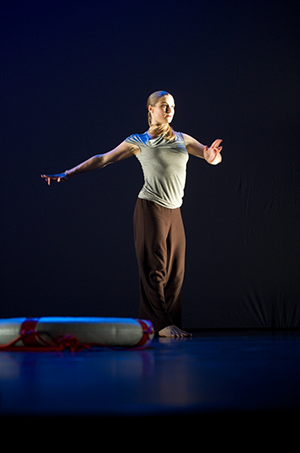 Dancer: Kamala Devam Dancer: Kamala Devam
Choreography: Kamala Devam with movement quotes in last section taken from Rashpal Singh Bansal's “Anything But Exotic” (2007)
Music: Colin Hay, Derek Trucks, Cold Play
Original sound design: Benjamin Henry Edwards (assisted by Kamala Devam)
Original Lighting Design: Angela Anson
Vocal Recording/Sound Engineering: Lesley Mommsen
Vocals: Kamala Devam
Costumes: Next, Marks and Spencer
Prop: Arthur Beale Sailing Shop
Fretless is a contemporary dance solo inspired by the loss of Kamala’s friend and choreographer Rashpal Singh Bansal. The dance uses Bharatanatyam and contemporary dance's athletic release-based vocabularies to delve experiences of trying to save someone, being the one who needs to be saved and of letting go of what keeps one safe - or perhaps trapped.
|
| |
| Ardhanariswara |
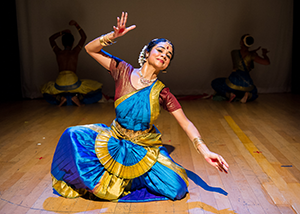 Dancers: Kadhambari Sridhar, Malini Srinivasan and Umesh Venkatesan Dancers: Kadhambari Sridhar, Malini Srinivasan and Umesh Venkatesan
Choreography: Malini Srinivasan
Music: Roopa Mahadevan, with rhythmic compositions (Jathis) by Akshay Anantapadmanabhan
(commissioned by Malini Srinivasan) in Ragamalika; Talas Adi, and Misra Chapu
Lyrics: Adi Sankara (788-820 CE)
"The Lord who is Half-Woman" (Ardhanarishwar) is a composite of Shiva and Shakti. This work celebrates the Oneness of the Two - Male and Female - through abstract dance, rhythm, melody and text. In the first half, the male and female dancers each express the essence of energetic or vigorous qualities (Tandava) and sensuous, flowing qualities (Lasya). As the rhythmic sections begin to converge in a traditional mridangam Koraippu, their movements also converge. The second half introduces a third dancer who represents both the composite male/female form as well as the devotee in wonder who recollects the astonishing attributes of this Divine Being.
|
| |
| INTERMISSION |
| |
| Priye Charusheele |
 Dancer: Rahul Acharya Dancer: Rahul Acharya
Choreography: Rahul Acharya
Music: Traditional, in Raga Desh; Tala Rupaka
Lyrics: Jayadeva (Gita Govinda)
Having spent the night with another woman, Krishna returns to the eagerly waiting Radha, who, by now is angered by Krishna's flirtatious nature. She shuns him and pleads with him to leave her alone. Chastened by Radha's anger, Krishna devises ways to woo her back. But his cunning words do not convince her. Facing imminent failure, Krishna falls at Radha's feet and asks her to place her lotus feet on his head. ( "Dehi pada pallavamudaram"). It is said that while attempting to write these lines, Jayadeva was deeply conflicted by the impropriety of what he was to represent i.e. that the Lord of the World begging Radha (a Devotee herself) to allow Him to touch her feet. Jayadeva was rescued from his turmoil by divine intervention when Krishna himself completed this couplet.
|
| |
| Taal Chakra |
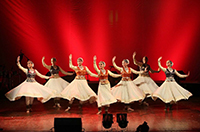 Dancers: Barkha Patel, Nikita Manilal, Alisha Kothari, Ashna Kothari and Ashna Mehta, of the Rachna Sarang Academy of Performing Arts Dancers: Barkha Patel, Nikita Manilal, Alisha Kothari, Ashna Kothari and Ashna Mehta, of the Rachna Sarang Academy of Performing Arts
Choreography: Guru Rachna Sarang
Music: Padmavibhushan Pandit Birju Maharaj, Tala Teentaal
Vocal syllables (Bol Padant): Guru Madhurita Sarang
Interpreting the Philosophies of Kabir and Ameer Khusrao
 Dancer-Composer: Rani Khannam Dancer-Composer: Rani Khannam
Music based on Poems by Kabir and Ameer Khusrao
In the poem, Rehna Nahi Desh Begana Hai, the iconoclastic 15th century mystic Kabir reminds us that this world that we call our home is just temporary. Why do we fear death when merging with the Absolute is the only constant space? (This song will be rendered in the baithak or seated mode.)
Writing the still popular song, Mohe Apne Rang Mein Rang Le Rangeele, a hundred years earlier, the Muslim Sufi saint Amir Khusrao pleads with his Beloved (the Almighty) to transform his material, monochromatic self by dyeing his being in the joyful spring colors of His Creation.
With the two danced poems, one from each of these iconic figures, Rani draws parallels between two great mystic traditions of India: Bhakti and Sufism, which both place a personal relationship with the Divine (Nisbat) above all else.
|
| |
|
| Q&A with dancers moderated by Rajika Puri |
| |
 |
for the indoor concert . |
| $35 general admission; $30 IAAC members |
|
| |
|
FESTIVAL PASS: $55 general admission $50 IAAC members

Includes tickets to every Erasing Borders Festival of Indian dance event from August 15-17, 2013. |
| |
| Aug 17, Saturday @ La Mama Rehearsal Studio, 47 Great Jones Street, First Floor, NYC |
| |
| |
|
| 11:00-12:00 |
WORKSHOP in Mohiniyattam by Vijayalakshmi
Tickets: $15 general admission; $12 IAAC members
 |
| |
|
| 12:15-1:15 |
WORKSHOP in Kathak by Rani Khanam
Tickets: $15 general admission; $12 IAAC members
 |
| |
|
| 1:15-2:30 |
LUNCH |
| |
|
| 2:30-3:30 |
PANEL DISCUSSION: Changing Perceptions of Indian Dance in North America
Tickets: $10 general admission; $8 IAAC members & students
|
| |
 |
| Moderator: Jonathan Hollander |
| Panelists: Guru Rachna Sarang, Mandakini Trivedi, Preeti Vasudevan, Parijat Desai |
| |
|
| 3:45-5:00 |
DANCE INHERITAGE FILMS & DISCUSSION
|
| |
$10 general admission; $8 IAAC members. |
| |
 |
| Moderator: Uttara Asha Coorlawalla-Lalvani |
| Panelists: Dulam Satyanarayana, Justin McCarthy |
| |
|
Excerpts from two new films on Indian dance's recent past: "I am Satyabhama" & "O friend this waiting" followed by a discussion of their contemporary relevance and context. We will also hear about the work of the Dance Heritage Coalition in Washington D.C. as well as a Q&A with filmmakers Dulam Satyanarayana and Justin McCarthy, moderated by Uttara Asha Coorlawala-Lalvani |
| |
"I am Satyabhama" starts with the life and performances of the legendary performer of female roles in Kuchipudi, Padmashri Vedantam Satyanarayana Sarma, and includes archival footage of his performances. This project to recover a lost past leads filmmaker Dulam Satyanaraya to the village of Kuchipudi where this dance form was developed and sustained since the thirteenth century.
O Friend, This Waiting by Bharatanatyam dancer (and pianist) Justin McCarthy and filmmaker Sandhya Kumar on Kshetrayya Padams, the most treasured love songs of the dancing devadasis who rose to prominence in the courts of the 17th century Nayaka rulers. O Friend, This Waiting is a creative re-envisioning of absence and presence as it revisits all the elements that we now understand as our inheritage from those Telugu courts. |
| |
|
All performers will be available for interviews. Images available on request. Please visit www.iaac.us for further information.
All media are invited to all Dance Festival events. Please rsvp Leena immediately. |
| |
FESTIVAL PASS: $55 general admission $50 IAAC members

Includes tickets to every Erasing Borders Festival of Indian dance event from August 15-17, 2013. |
| |
| Sponsors |
    
   |
|
|













